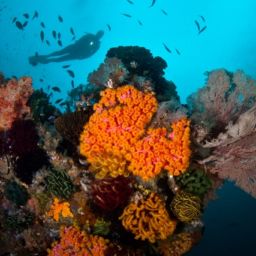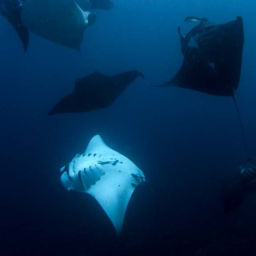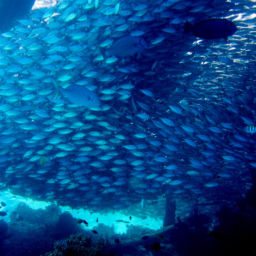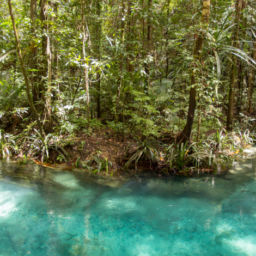Translated from Indonesian, Raja Ampat means “Four Kings.” While those who named it were probably unaware of the majestic beauty of the dive sites below the surface, the name is still quite fitting. The region holds 1,400 documented fish species, with more discoveries ongoing, and 75 percent of all known coral species. Most experienced scuba divers have heard of the legendary scuba diving in Raja Ampat. I recently discovered that this reputation is well deserved, along with another pleasant discovery — unlike most “bucket-list” dive destinations, visitors can dive Raja Ampat affordably without compromising the dive quality.
Scuba diving in Raja Ampat
Raja Ampat is part of the Coral Triangle, where divers can find some of the world’s healthiest, most biodiverse reefs. The diving here is mind-blowing — at times I felt as if someone had slipped a hallucinogen in my early morning coffee. It would be impossible to do justice to the scuba diving in Raja Ampat in a short article or with the short video I shot below with my GoPro. Rather, I’ll emphasize the beauty and diversity of Raja and its surprising accessibility to most scuba divers in terms of travel and budgeting.
Getting to Raja Ampat from most locations in the world is no doubt expensive. But once you get there, it is possible to dive on a budget. To do the area justice, you must split the diving into two parts, north and south. Fly into the main airport, Domine Eduard Osok, in Sorong. From there you can either board a liveaboard or head to a land-based resort and dive north of Waigeo, or central/south Waigeo.
Liveaboard dive boats commonly visit the area, and a typical budget for a trip on one would be around $6,000 a week. For a week stay at Raja Ampat Biodiversity Eco Resort, I accessed the same pristine sites for approximately $2,000. I dove mainly in central/north Waigeo, with the following dive sites making up the absolute must-dos for the area.
The Passage
This site offers fantastic muck diving. Ironically, while our group was searching for nudibranchs and other critters in the sand, the boat captain reported five mantas swimming past us in the channel, so you never know what you’ll get.
Melissa’s Garden
You’ll dive this site in conjunction with a Fam Islands trip. In store for you is a seemingly infinite coral garden of elkhorn and finger corals.
Blue Magic
After surfacing from this dive, I simply couldn’t help but sing the words “Oh, Oh, Oh it’s magic,” as indeed this site is pure magic. This offshore seamount offers hundreds of schooling jacks, wobbegong sharks, turtles and beautiful corals.
Cape Kri
Cape Kri is world famous for having the highest number of different fish species counted in one place, including reef species, schooling jacks and other blue-water fish.
Chicken Reef
Chicken Reef was probably one of my favorites, with a mind-blowing variety of corals, schooling fish and different marine species.
Mike’s Point
At Mike’s Point, we saw bumphead parrotfish at depth. We saw amazing topography from where a WWII bomb hit the site, beautiful corals, hundreds of different reef fish and schooling baitfish in the shallows.
Even the house reef at the resort had octopus, eels, blacktip reef sharks. They recently discovered walking sharks here as well, which you can see on night dives or snorkel trips. There is also a coral nursery harvested on the house reef to educate visitors, interns and locals.
Logistics
Indonesia’s international airports include Bali, Jakarta, Manado and Makassar. You’ll fly on to Sorong from there.
Electricity is 220/110 volts. Bring international outlet adaptors
Internet access is available in main towns, but almost non-existent on liveaboards and at remote resorts. It is possible to get some connectivity with a local SIM card/data pack.
The weather and water temperatures are tropical, between 79 and 88 F (26 to 31 C). Raja offers year-round diving, with busier periods from October to May. The southeast monsoon, between May and September, delivers most of Raja Ampat’s annual rainfall. You can still dive during that time, however, as it typically doesn’t rain all day.









